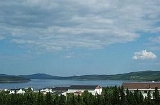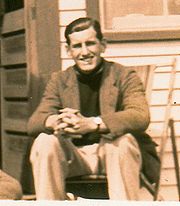
Port Hope Simpson, Newfoundland and Labrador
Encyclopedia
Port Hope Simpson, population 529 (2006), is a town located on the southeastern Labrador
coast, 215 kilometres from the Quebec
/Labrador border. It had its beginnings in the 1930s as a company town.
The town is serviced by a ferry
connection to a nearby town
of William's Harbour. It also has a small regional airport
serviced by Air Labrador
. It has a friendly, independent people with a compelling history and a priority of sustainable economic development in a region of unspoilt wilderness. With the recent completion of the Trans-Labrador Highway
through the region, Port Hope Simpson has since had an increase in tourist activity.
The nearby Shinneys Water Complex makes up 2,500 square kilometers of over 1,000 islands rising dramatically above sea level. These protected waters are ideal for all types of boating
and the adjoining Alexis River
is a popular fishing destination for Atlantic salmon
.
 Job Notley and his family were the first permanent inhabitants in the locality living on an island at Light Tickle, to the east of the townsite and in 1884 a census recorded eight persons living at Alexis River. Lif was at a subsistence level based on fishing, trapping and hunting. Any timber cut from the dense coniferous woods in the area was limited to building log shacks, trestles, furniture, komatiks and firewood.
Job Notley and his family were the first permanent inhabitants in the locality living on an island at Light Tickle, to the east of the townsite and in 1884 a census recorded eight persons living at Alexis River. Lif was at a subsistence level based on fishing, trapping and hunting. Any timber cut from the dense coniferous woods in the area was limited to building log shacks, trestles, furniture, komatiks and firewood.
It was not until 1934 that Port Hope Simpson was founded as a logging town by John Osborn Williams
, owner of the Labrador Development Company, which set-up a pitwood cutting and exporting operations on the present townsite. He was supported in his venture by Sir John Hope Simpson, Commissioner of Natural Resources and Acting-Commissioner of Justice 1934-36. Simpson had agreed to Williams's offer that the settlement should be named after himself. This left the Commission and the British Government open to accusations of favouritism in their dealings with Williams. The government soon regretted the business relationship with Williams when it discovered that British taxpayers' money had been borrowed under false intentions.
The first Post Office was established on October 21st 1950. The first Postmaster was Hayward Green. At the time, the population was 311.
Williams kept his workers in poverty and in debt by the credit system he used at the Company store. Nonetheless, 1934-1940 saw six years of great economic activity as thousands of pit prop
s were shipped from Port Hope Simpson as Britain
and her allies prepared for the Second World War. There were still no roads in May 1941 - seven years after the company had first arrived. During this time some workers left for work elsewhere in Goose Bay and in Newfoundland
.
Due to the low wages the remaining loggers went on strike, however, when they returned to work they were charged increased rents. People relied to some extent for fish caught locally, however by 1942, all the fishing families had left as well. Starvation faced the people. and then the company began to close down. There was a steady decline in government largesse as the people fell back once more on fishing and trapping to survive.
A public enquiry into his company financial affairs in 1945. Williams managed to deceive Supreme Court Judge Brian Dunfield that he necessarily operated on a shoestring, implying that allowances should be made accordingly. To hide his earnings, the Company's pit props were purchased by one of his other companies - J. O. Williams and Company. It wasn't until many years later that the Labrador Development Company was finally closed down but the common denominator of secrecy, in particular about how Eric and his infant daughter had died still remains active today 7 May 2009.
 At this point an alleged cover-up about the deaths was put in place beginning with the appointment of Claude Fraser, Simpson's loyal secretary
At this point an alleged cover-up about the deaths was put in place beginning with the appointment of Claude Fraser, Simpson's loyal secretary
of Natural Resources, as Government Director of the company on the same day as the deaths occurred. In August 2002 The Royal Canadian Mounted Police
, under the Department of Justice, decided to open an investigation about whether or not foul play
had occurred. Since no satisfactory explanation for what happened has yet been found their file remains open.
Since no satisfactory explanation for what happened has yet been found their file remains open.
arrived 14 years later.
New economic activity took place between 1962 and 1968 as Bowater picked-up the thread laid down by Williams, Simpson and the Labrador Development Company. More trees were felled for their pulp and paper mills at Corner Brook, and in Kent, England. Bowater brought benefits of regular paid employment (though seasonal), twenty miles of forest roads and the government contributed by sharing the cost of building a new wharf. But by 1970, apart from the post office, the general store and the two schools there was no year-round paid employment.
From 1970 to 1992 cod
and salmon
fishing was the economic mainstay of the area but unemployment prevailed most of the year. In 1992 the cod fishery was closed down altogether. However, many local fishermen made a relatively easy transition into crab
, shrimp
and scallop
fishing.
In 1996, Port Hope Simpson was granted the town status. A manufacturing industry has developed by diversification into boat-building. The construction works of the Trans-Labrador Highway and the new Port Hope Simpson bridge and the airport have done much to increase accessibility
. Improved accessibility has been crucial in bringing visitors to the town.
Labrador
Labrador is the distinct, northerly region of the Canadian province of Newfoundland and Labrador. It comprises the mainland portion of the province, separated from the island of Newfoundland by the Strait of Belle Isle...
coast, 215 kilometres from the Quebec
Quebec
Quebec or is a province in east-central Canada. It is the only Canadian province with a predominantly French-speaking population and the only one whose sole official language is French at the provincial level....
/Labrador border. It had its beginnings in the 1930s as a company town.
The town is serviced by a ferry
Ferry
A ferry is a form of transportation, usually a boat, but sometimes a ship, used to carry primarily passengers, and sometimes vehicles and cargo as well, across a body of water. Most ferries operate on regular, frequent, return services...
connection to a nearby town
Town
A town is a human settlement larger than a village but smaller than a city. The size a settlement must be in order to be called a "town" varies considerably in different parts of the world, so that, for example, many American "small towns" seem to British people to be no more than villages, while...
of William's Harbour. It also has a small regional airport
Port Hope Simpson Airport
Port Hope Simpson Airport is south of Port Hope Simpson, Newfoundland and Labrador, Canada....
serviced by Air Labrador
Air Labrador
Labrador Airways Limited, operating as Air Labrador, is a regional airline based in Goose Bay , Newfoundland and Labrador, Canada. It operates scheduled daily passenger and freight services throughout Labrador and Quebec, as well as charter operations with the options of landing in remote and off...
. It has a friendly, independent people with a compelling history and a priority of sustainable economic development in a region of unspoilt wilderness. With the recent completion of the Trans-Labrador Highway
Trans-Labrador Highway
The Trans-Labrador Highway is a Canadian highway located in the province of Newfoundland and Labrador. It is the primary public road in Labrador and one of the few in that part of the province....
through the region, Port Hope Simpson has since had an increase in tourist activity.
The nearby Shinneys Water Complex makes up 2,500 square kilometers of over 1,000 islands rising dramatically above sea level. These protected waters are ideal for all types of boating
Boating
Boating is the leisurely activity of travelling by boat, or the recreational use of a boat whether powerboats, sailboats, or man-powered vessels , focused on the travel itself, as well as sports activities, such as fishing or water skiing...
and the adjoining Alexis River
River
A river is a natural watercourse, usually freshwater, flowing towards an ocean, a lake, a sea, or another river. In a few cases, a river simply flows into the ground or dries up completely before reaching another body of water. Small rivers may also be called by several other names, including...
is a popular fishing destination for Atlantic salmon
Atlantic salmon
The Atlantic salmon is a species of fish in the family Salmonidae, which is found in the northern Atlantic Ocean and in rivers that flow into the north Atlantic and the north Pacific....
.
Early settlement and founding
The earliest signs of habitation in the Port Hope Simpson area are marks dating from 1773 carved in a rock known as the "stamp from our past" when a few inhabitants were wintering at various places on Alexis and Gilbert Bays.
It was not until 1934 that Port Hope Simpson was founded as a logging town by John Osborn Williams
John Osborn Williams
John Osborn Williams was the owner of the logging and pit prop exporting business known as The Labrador Development Company limited based in Port Hope Simpson from 1934-1948....
, owner of the Labrador Development Company, which set-up a pitwood cutting and exporting operations on the present townsite. He was supported in his venture by Sir John Hope Simpson, Commissioner of Natural Resources and Acting-Commissioner of Justice 1934-36. Simpson had agreed to Williams's offer that the settlement should be named after himself. This left the Commission and the British Government open to accusations of favouritism in their dealings with Williams. The government soon regretted the business relationship with Williams when it discovered that British taxpayers' money had been borrowed under false intentions.
The first Post Office was established on October 21st 1950. The first Postmaster was Hayward Green. At the time, the population was 311.
Hard life in a company town
Williams did not build 400 houses for the loggers and their families as promised. Neither did he pay good wages. The people felt betrayed.Williams kept his workers in poverty and in debt by the credit system he used at the Company store. Nonetheless, 1934-1940 saw six years of great economic activity as thousands of pit prop
Pit prop
A pit prop or mine prop is a length of lumber used to prop up the roofs of tunnels in coal mines.Canada traditionally supplied pit props to the British market...
s were shipped from Port Hope Simpson as Britain
United Kingdom
The United Kingdom of Great Britain and Northern IrelandIn the United Kingdom and Dependencies, other languages have been officially recognised as legitimate autochthonous languages under the European Charter for Regional or Minority Languages...
and her allies prepared for the Second World War. There were still no roads in May 1941 - seven years after the company had first arrived. During this time some workers left for work elsewhere in Goose Bay and in Newfoundland
Newfoundland and Labrador
Newfoundland and Labrador is the easternmost province of Canada. Situated in the country's Atlantic region, it incorporates the island of Newfoundland and mainland Labrador with a combined area of . As of April 2011, the province's estimated population is 508,400...
.
Due to the low wages the remaining loggers went on strike, however, when they returned to work they were charged increased rents. People relied to some extent for fish caught locally, however by 1942, all the fishing families had left as well. Starvation faced the people. and then the company began to close down. There was a steady decline in government largesse as the people fell back once more on fishing and trapping to survive.
The Labrador Development Company's Closure
Williams never relinquished legal control of the company to the Government's board of directors in St. John's, Newfoundland and he and his solicitors knew there was nothing the British Government, the Dominions Office nor the Commission of Government could do about it. He had misrepresented his own personal wealth to the government and the wages he paid his loggers had been much less than he claimed. Williams was also very economical with the truth about what development was really like on site. He had borrowed money at a time when the Commission of government was working to cut the Newfoundland debt and when his own country was preparing for war]. This was money that he was not in a rush to repay and which he used unscrupulously for other purposes.A public enquiry into his company financial affairs in 1945. Williams managed to deceive Supreme Court Judge Brian Dunfield that he necessarily operated on a shoestring, implying that allowances should be made accordingly. To hide his earnings, the Company's pit props were purchased by one of his other companies - J. O. Williams and Company. It wasn't until many years later that the Labrador Development Company was finally closed down but the common denominator of secrecy, in particular about how Eric and his infant daughter had died still remains active today 7 May 2009.
Intrigue and R.C.M.P.Investigation into the Two Unsolved Deaths Opened for the First Time in 2002 Under the Jursidication of Canada's Department of Justice
While this was going on, Williams was himself being cheated by his manager Keith Yonge. Williams sent his eldest son Eric to Port Hope Simpson to report on affairs in the town. The young man never returned. He died in a reported house fire with his infant daughter Erica.
Secretary
A secretary, or administrative assistant, is a person whose work consists of supporting management, including executives, using a variety of project management, communication & organizational skills. These functions may be entirely carried out to assist one other employee or may be for the benefit...
of Natural Resources, as Government Director of the company on the same day as the deaths occurred. In August 2002 The Royal Canadian Mounted Police
Royal Canadian Mounted Police
The Royal Canadian Mounted Police , literally ‘Royal Gendarmerie of Canada’; colloquially known as The Mounties, and internally as ‘The Force’) is the national police force of Canada, and one of the most recognized of its kind in the world. It is unique in the world as a national, federal,...
, under the Department of Justice, decided to open an investigation about whether or not foul play
Crime
Crime is the breach of rules or laws for which some governing authority can ultimately prescribe a conviction...
had occurred.

Port Hope Simpson today
This crucible of political, economic and social factors has been influential in the development of the town. Different characters, government officials and policies, the availability of work and how well its people have adapted to changing economic circumstances have combined together to explain the nature of its growth. When the Labrador Development Company left in 1948 leaving confusion, bitterness and a hoary, wild west reputation in its wake, paid work in the woods left with it until BowaterBowater
Bowater was an American pulp and paper company based in Greenville, South Carolina. Bowater had 12 pulp and paper mills in the United States, Canada and South Korea and 13 North American sawmills. It had approximately 10,000 employees...
arrived 14 years later.
New economic activity took place between 1962 and 1968 as Bowater picked-up the thread laid down by Williams, Simpson and the Labrador Development Company. More trees were felled for their pulp and paper mills at Corner Brook, and in Kent, England. Bowater brought benefits of regular paid employment (though seasonal), twenty miles of forest roads and the government contributed by sharing the cost of building a new wharf. But by 1970, apart from the post office, the general store and the two schools there was no year-round paid employment.
From 1970 to 1992 cod
Cod
Cod is the common name for genus Gadus, belonging to the family Gadidae, and is also used in the common name for various other fishes. Cod is a popular food with a mild flavor, low fat content and a dense, flaky white flesh. Cod livers are processed to make cod liver oil, an important source of...
and salmon
Salmon
Salmon is the common name for several species of fish in the family Salmonidae. Several other fish in the same family are called trout; the difference is often said to be that salmon migrate and trout are resident, but this distinction does not strictly hold true...
fishing was the economic mainstay of the area but unemployment prevailed most of the year. In 1992 the cod fishery was closed down altogether. However, many local fishermen made a relatively easy transition into crab
Crab
True crabs are decapod crustaceans of the infraorder Brachyura, which typically have a very short projecting "tail" , or where the reduced abdomen is entirely hidden under the thorax...
, shrimp
Shrimp
Shrimp are swimming, decapod crustaceans classified in the infraorder Caridea, found widely around the world in both fresh and salt water. Adult shrimp are filter feeding benthic animals living close to the bottom. They can live in schools and can swim rapidly backwards. Shrimp are an important...
and scallop
Scallop
A scallop is a marine bivalve mollusk of the family Pectinidae. Scallops are a cosmopolitan family, found in all of the world's oceans. Many scallops are highly prized as a food source...
fishing.
In 1996, Port Hope Simpson was granted the town status. A manufacturing industry has developed by diversification into boat-building. The construction works of the Trans-Labrador Highway and the new Port Hope Simpson bridge and the airport have done much to increase accessibility
Accessibility
Accessibility is a general term used to describe the degree to which a product, device, service, or environment is available to as many people as possible. Accessibility can be viewed as the "ability to access" and benefit from some system or entity...
. Improved accessibility has been crucial in bringing visitors to the town.
Population change
- 1945: 352 (Source: Southeastern Aurora Development Corporation);
- 1951: 252 (S.A.D.C.);
- 1965: 489 (S.A.D.C.);
- Mid 1980s: approximately 650 (S.A.D.C.);
- 1992: approximately 530 (S.A.D.C.);
- 1996: 577 (Source: Statistics Canada);
- 2001: 509 (S.C.)
- 2002: 535 (S.A.D.C.)
- 2006: 529 (S. C.)

